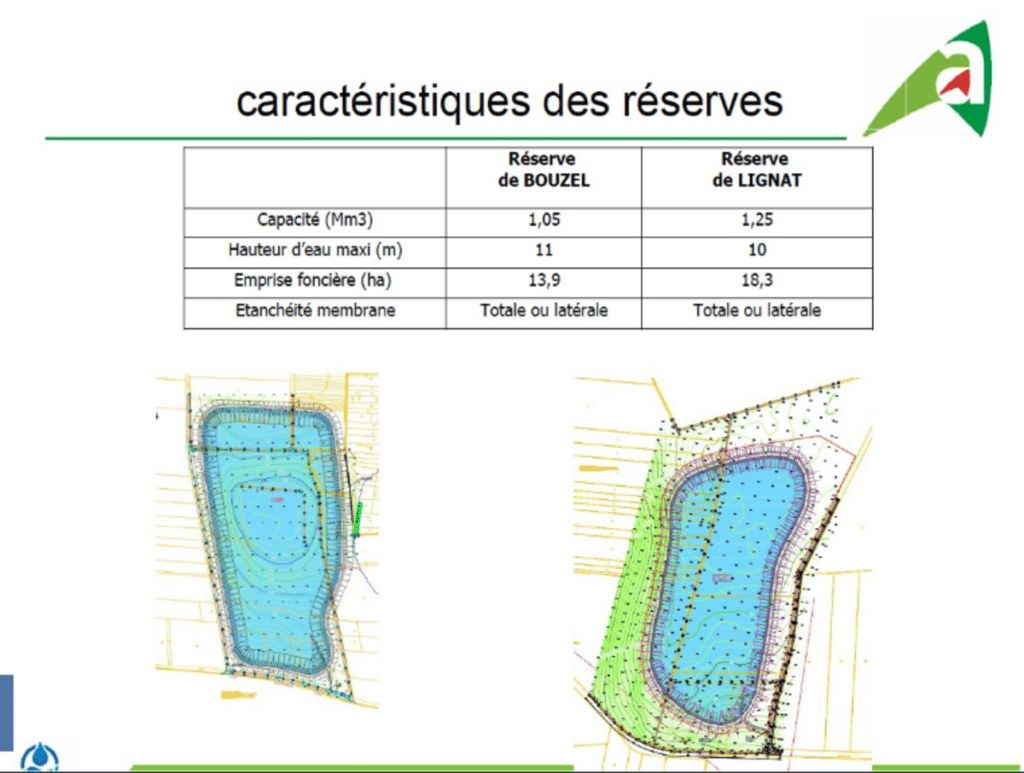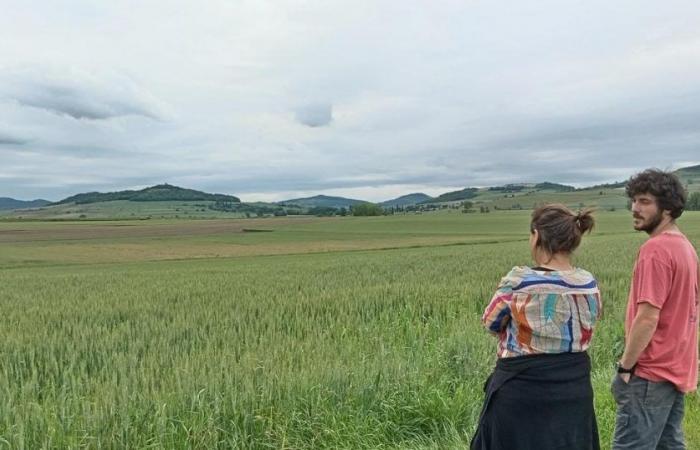“Allier is our ally”. This eco-friendly slogan, in homage to the river of the same name, is displayed on a wall in Billom, near Clermont-Ferrand (Puy-de-Dôme). The sector has become one of the hotspots for mobilization against mega-basins in France. United in a free trade union association, the ASL des Turleuros, 36 farmers plan to build two artificial water reservoirs to irrigate 800 hectares of crops during summer drought. Total volume envisaged for the two structures: 2.3 million cubic meters, for an artificial surface area of 32 hectares. Enough to put them virtually on the podium of the biggest mega-basins in France. So, good or bad idea?
Pump water in winter to irrigate in summer
Here, water would be pumped into the Allier River. This river crosses several departments, including Puy-de-Dôme, before flowing into the Loire. A supply system different from the media mega-basin of Sainte-Soline (Deux-Sèvres), which draws from the water table. But, in both cases, the farmers’ argument is the same: it is better to fetch water in winter, when it is more abundant. Then store it in the open air, in order to reuse it in summer, thus preserving low-flow waterways.
In their latest press release, these farmers of the agricultural plain of Limagne, land of large cereal crops, say they are “faced with the recurrence and intensification of episodes of drought and excess precipitation. Understand: sometimes the rain is lacking, sometimes it is abundant. A consequence of climate change. In 2023, a dry year, the municipalities around Billom were classified “in crisis” – the most serious level of drought orders – until November. The Naussac dam, in Lozère, used to replenish the Allier in the summer, had reached a historically low filling rate of 21%. None of the ASL des Turlurons farmers contacted by Green did not wish to discuss in more detail the interest of this project in the face of declining hydrology. According to them, however, it is “responsible and supervised, committed to serving local sectors”.
A solution to the industrial agricultural model
This silence does not surprise Maud, an activist within the Bassines non merci collective of Puy-de-Dôme (BNM63) and the agricultural union Confédération paysanne 63. She points out “an insidious climate and an omerta in the village”. The house in which this organic berry producer grew up, in Bouzel, is visible from the area where one of the two mega-basins could be built. 14 hectares would be artificialized and covered with plastic. “It was already no longer a bocage environment in my youth, but the plots have only grown larger”traces the bitter forty-year-old during our visit to the place.
In fact, these agricultural irrigation reserves would come, at least in part, to the aid of agriculture that is today industrial and geared towards the export of seeds. To the detriment of local food? “Our project aims to secure agricultural and food production in Limagne in all its diversity,” the farmers of the ASL des Turlurons defend themselves.
However, a majority of them are members of the Auvergne Limagrain cooperative, a powerful multinational and the fourth largest seed group in the world. France relies in part on the giant to rise to the top of the world ranking of seed exporters. In an interview with the local newspaper La Montagne, the president of Limagrain, Sébastien Vidal, personally involved among the 36 farmers, explained this at the beginning of May. According to him, the deductions are “a short-term solution […] Today we need water to maintain this agricultural model”.
This is the real issue of the debate. Yes, these mega-basins can be a temporary palliative to climate change. But they will not solve the underlying problem. “Storage will make it possible to act as if there was no climate change, but that is short-sighted”summarizes Nadia Carluer, hydrologist at INRAE. “The volume of these two reservoirs is not enough to assess the relevance of the project, even if in absolute terms it seems very large. The use of reservoirs is sometimes essential to secure production in very dry years. For example, for subsistence agriculture such as market gardening. But everything must be done so that the natural storage of water can also take place”. Which implies an evolution of the local agricultural model. In order for the soils to regain their infiltration and retention capacity, the specialist cites various agroecological practices to be amplified: permanent soil cover, planting hedges and creating valleys, for example.
An insufficient approach to future droughts
However, this transition towards agroecology is not on the agenda in the sector, laments Anton Deums, one of the spokespersons for BNM63. On the contrary, these mega-basins risk blocking this agricultural model. This is based on the cultivation of seed corn and other seed crops — for seed production. It is intensive in chemical inputs and water, very lucrative for Limagrain and has a beneficial effect on France’s trade balance.
But it is also disastrous for the local environment. “This agriculture creates deserts. The soils, depleted, disappear as soon as it rains [en raison de l’érosion, NDLR]. Yet it is our common capital”said the activist, pointing to the Jauron, a tributary of the Allier with brown water, near the site of the planned mega-basin in Bouzel.
He wishes to see the emergence of “agricultural systems that produce while infiltrating water, storing carbon and supporting biodiversity”. “A small maple survived there”, he suddenly points out mischievously. On May 11, more than 6,000 people gathered here to protest against the project to build these water reservoirs. Small trees had been planted around the plot, but many have since been cut down. “However, it is beneficial work for farmers”quips the thirty-year-old.
In the medium term, mega-basins will no longer be enough. “We are already seeing it in Spain”illustrates Nadia Carluer: “The country has gone much further than us in water storage. For several years, the reservoirs have not been filling and it is an entire agricultural system that is not doing well.. In France too, water resources are running out. Between 1983 and 2022, the annual flow of the Allier decreased by approximately 21%. Winter droughts are already a reality.

However, the ASL of Turleuros presents reassuring figures, with a complete filling of reservoirs which would have been possible 23 years out of 24 since 2000. But what will it be in the future? According to the Hydrology Milieux Usages Climat (HMUC) study, currently being finalized and deployed in the Allier watershed, flows could drop by 16% on average during the winter months in a “dry” year by by 2030, and 49% by 2050. Scenarios based on a lack of change in current uses. Gold, “it is very likely that this type of project will multiply, especially if the ASL project is accepted”BNM 63 redoubt. From then on, “the cumulative impact could very quickly become truly significant for Allier”. And, in a context of water deficit, a source of even harsher conflicts around the distribution of water.
Massive support from the State and the Region
Hydrologist Nadia Carluer is currently working on writing a book on water sharing in the Anthropocene. She is responsible for coordinating the chapter on water storage. However, it is difficult to know to what extent projects of this type are multiplying in the territory, beyond the major publicized cases. “These data are not aggregated at the national level”regrets the specialist, who has nevertheless been calling for it since 2016. For research, it is therefore difficult to comment on the question of the cumulative impacts of these works on water resources in France.
However, the government committed, at the end of April, to accelerating 100 agricultural water storage or irrigation projects so that they are “finalized by the end of 2024”. An acceleration driven by public money, for a minority of farmers. The ASL Turlurons project, estimated at 25 million euros, is for example eligible for regional subsidies, via the European Agricultural Fund for Rural Development (EAFRD). The Auvergne-Rhône-Alpes Region confirmed to us that it had financed 70% of the cost of the feasibility studies. But the first results were not conclusive. The location envisaged for the second 18 hectare reservoir did not meet certain geotechnical conditions. “Other sites will need to be assessed”, adds the Region, without further details. In the meantime, BNM63 announces Green that the opponents are already preparing for possible legal action in the event of filing the file with the prefecture.








